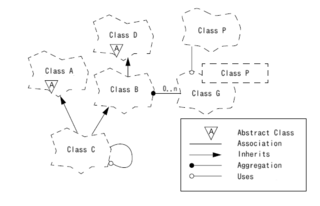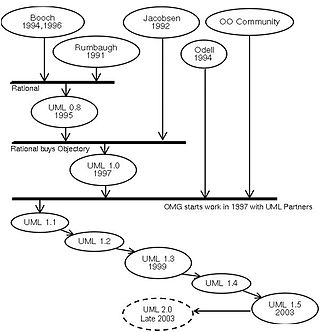Related Research Articles

The Booch method is a method for object-oriented software development. It is composed of an object modeling language, an iterative object-oriented development process, and a set of recommended practices.

An object-modeling language is a standardized set of symbols used to model a software system using an object-oriented framework. The symbols can be either informal or formal ranging from predefined graphical templates to formal object models defined by grammars and specifications.

The unified modeling language (UML) is a general-purpose visual modeling language that is intended to provide a standard way to visualize the design of a system.
The rational unified process (RUP) is an iterative software development process framework created by the Rational Software Corporation, a division of IBM since 2003. RUP is not a single concrete prescriptive process, but rather an adaptable process framework, intended to be tailored by the development organizations and software project teams that will select the elements of the process that are appropriate for their needs. RUP is a specific implementation of the Unified Process.
In software and systems engineering, the phrase use case is a polyseme with two senses:
- A usage scenario for a piece of software; often used in the plural to suggest situations where a piece of software may be useful.
- A potential scenario in which a system receives an external request and responds to it.

Grady Booch is an American software engineer, best known for developing the Unified Modeling Language (UML) with Ivar Jacobson and James Rumbaugh. He is recognized internationally for his innovative work in software architecture, software engineering, and collaborative development environments.

Computer-aided software engineering (CASE) was a domain of software tools used to design and implement applications. CASE tools were similar to and were partly inspired by Computer-Aided Design (CAD) tools used for designing hardware products. CASE tools were intended to help develop high-quality, defect-free, and maintainable software. CASE software was often associated with methods for the development of information systems together with automated tools that could be used in the software development process.

Objecteering is a UML and MDA CASE tool edited by Objecteering Software, a subsidiary of Softeam.

Ivar Hjalmar Jacobson is a Swedish computer scientist and software engineer, known as major contributor to UML, Objectory, Rational Unified Process (RUP), aspect-oriented software development and Essence.
Object-oriented analysis and design (OOAD) is a technical approach for analyzing and designing an application, system, or business by applying object-oriented programming, as well as using visual modeling throughout the software development process to guide stakeholder communication and product quality.
Together is a product from Micro Focus, formerly from Borland, formerly from TogetherSoft, that currently integrates a Java IDE, which originally had its roots in JBuilder, with a UML modeling tool.

StarUML is a software engineering tool for system modeling using the Unified Modeling Language, as well as Systems Modeling Language, and classical modeling notations. It is published by MKLabs and is available on Windows, Linux and MacOS.

Unicom System Architect is an enterprise architecture tool that is used by the business and technology departments of corporations and government agencies to model their business operations and the systems, applications, and databases that support them. System Architect is used to build architectures using various frameworks including TOGAF, ArchiMate, DoDAF, MODAF, NAF and standard method notations such as sysML, UML, BPMN, and relational data modeling. System Architect is developed by UNICOM Systems, a division of UNICOM Global, a United States-based company.
I-Logix was a leading provider of Collaborative Model driven development (MDD) solutions for systems design through software development focused on real-time embedded applications. Founded in 1987, the Andover, Massachusetts-based company product line enhanced collaboration among engineers, graphically modeling the requirements, behavior, and functionality of embedded systems. In addition, I-Logix was a member of the UML Partners, a group devoted to the development of the Unified Modeling Language (UML).
Model-driven engineering (MDE) is a software development methodology that focuses on creating and exploiting domain models, which are conceptual models of all the topics related to a specific problem. Hence, it highlights and aims at abstract representations of the knowledge and activities that govern a particular application domain, rather than the computing concepts.
Telelogic AB was a software business headquartered in Malmö, Sweden. Telelogic was founded in 1983 as a research and development arm of Televerket, the Swedish department of telecom. It was later acquired by IBM Rational, and exists under the IBM software group.
Rational Rose XDE, an "eXtended Development Environment" for software developers, integrates with Microsoft Visual Studio .NET and Rational Application Developer. The Rational Software division of IBM, which previously produced Rational Rose, wrote this software.
Rational Rhapsody, a modeling environment based on UML, is a visual development environment for systems engineers and software developers creating real-time or embedded systems and software. Rational Rhapsody uses graphical models to generate software applications in various languages including C, C++, Ada, Java and C#.

Rational Software Modeler (RSM), made by IBM's Rational Software division, is a Unified Modeling Language (UML) 2.0-based visual modeling and design tool. Rational Software Modeler is based on the Eclipse open-source software framework and is used for visual modeling and model-driven development (MDD) with UML for creating applications and web services. IBM ceased marketing Rational Software Modeler in 2010 and ended support for it in 2015. Much of the same functionality is now available through Rational Software Architect.
ObjecTime Developer is a software automation tool designed to meet the development needs of real-time software development teams. The tool was created by ObjecTime Limited of Kanata, Ontario, and was aimed at aiding software developers in building applications using Real-Time Object-Oriented Modeling (ROOM) for real-time, graphical design models. ObjecTime, using the design models, will then generate production-quality applications for real-time operating systems, using the C and C++ programming languages. An important aspect of the development process using OTD was the capability to visually see the execution of the generated software as animation of the design models. This was true both for the software running both on the development or target platform.
References
- ↑ Lohr, Steve (7 December 2002). "I.B.M. to Acquire Rational In Big Move Into Software". The New York Times. Retrieved 22 December 2020.
- ↑ McCarthy, Glenda (7 December 2002). "IBM to Purchase Rational Software". Los Angeles Times. Retrieved 22 December 2020.